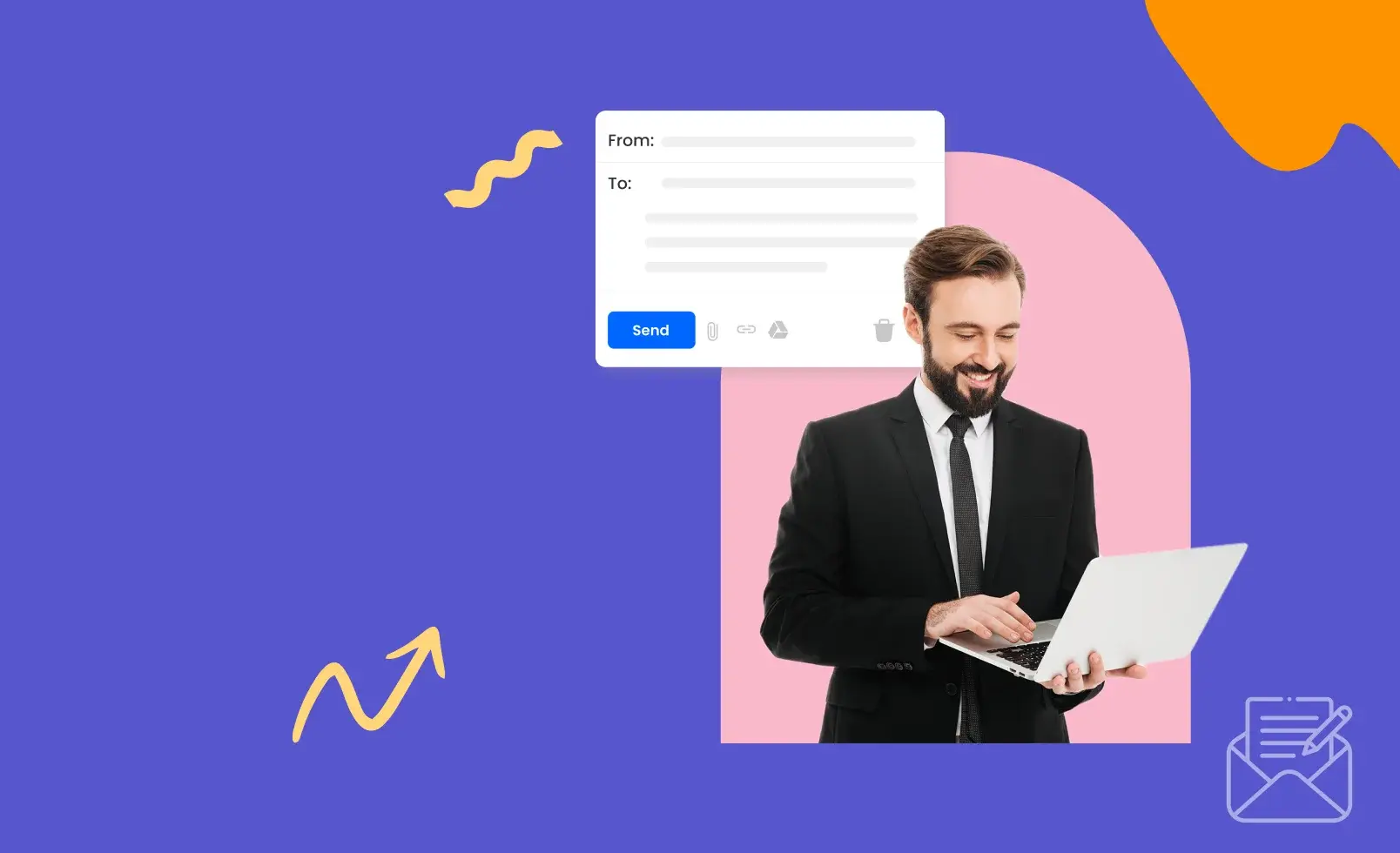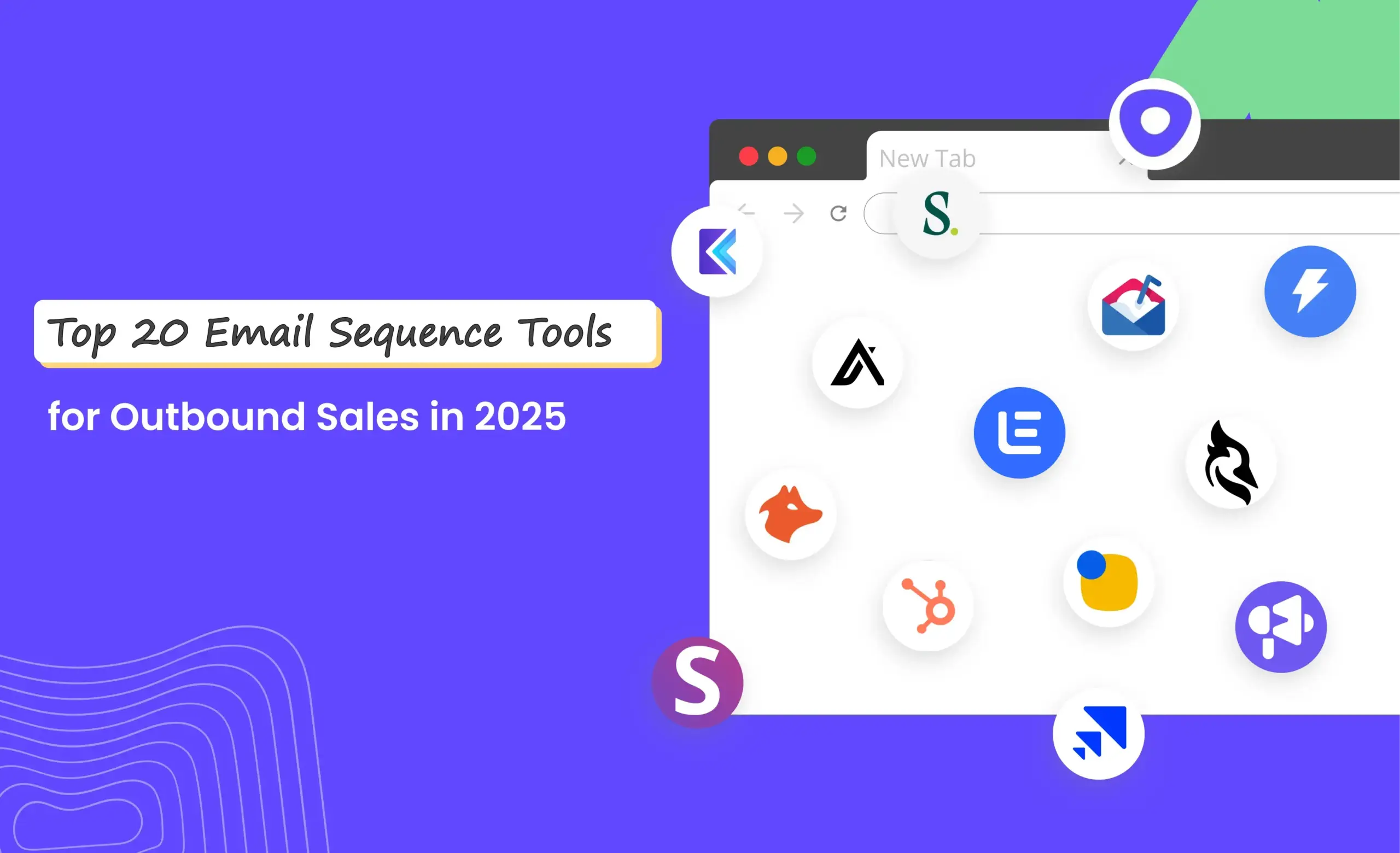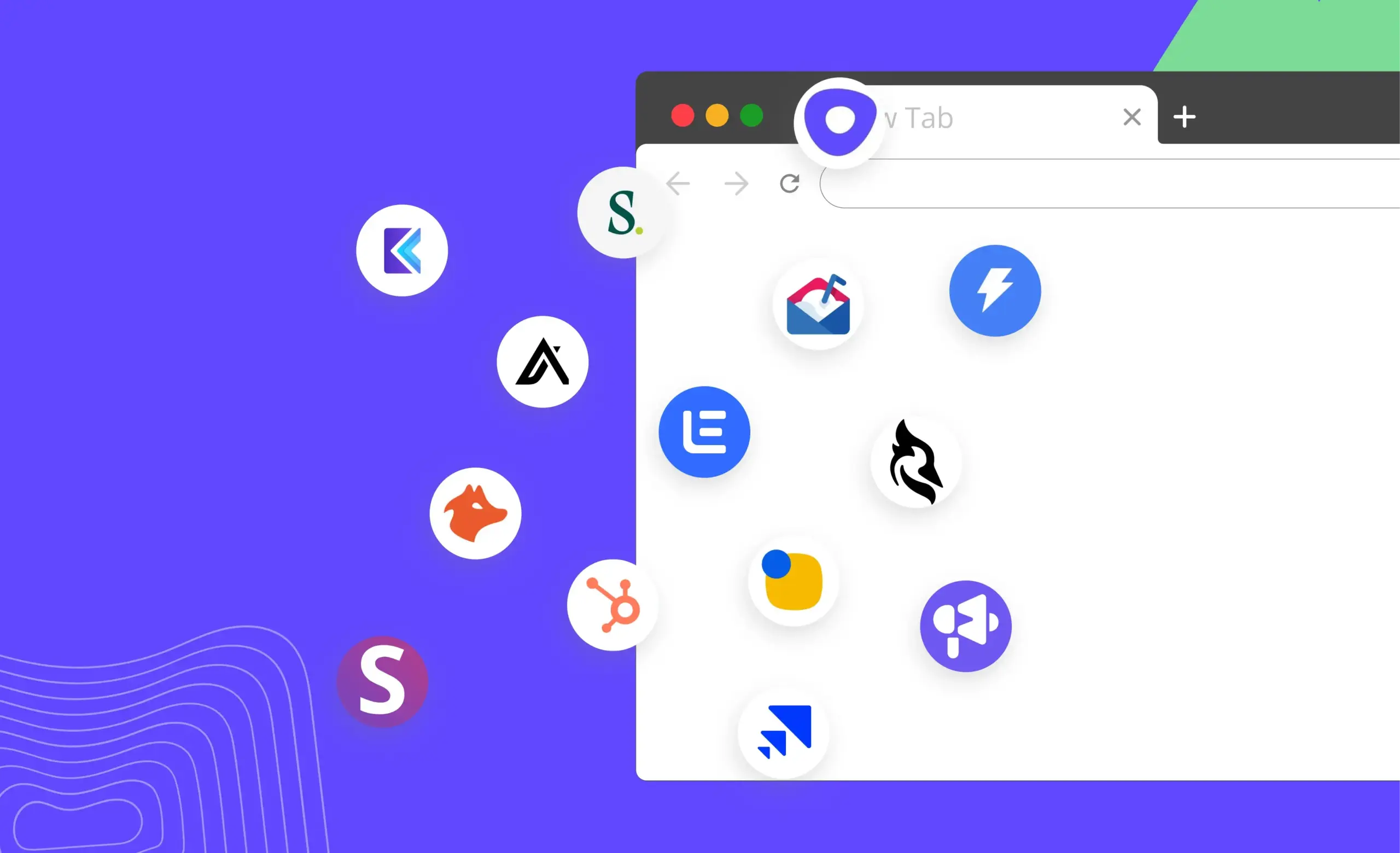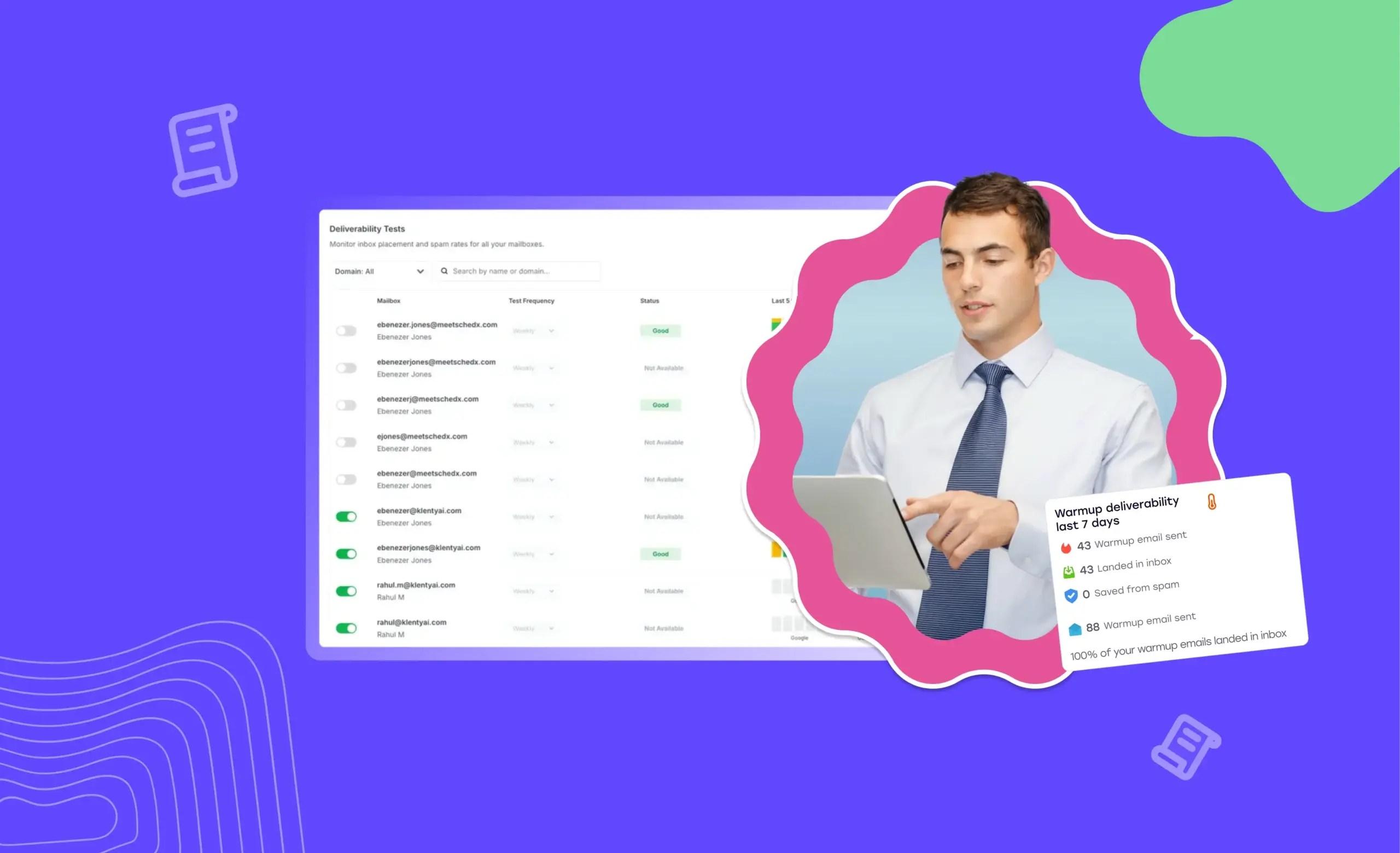You've probably heard of this age-old adage: "You never get a second chance to make a first impression."
This especially rings true for cold email outreach, where you're practically reaching out to absolute strangers.
Your prospects receive a barrage of emails from different sales representatives every day and have become quite adept at swiping left on anything that doesn't catch their interest.
And if crafting compelling emails wasn't already difficult, this just pushes the bar a lot higher.
After all, an excellent sales introduction email can be the difference between a successful connection that takes you closer to your business goals and a missed opportunity.
In this blog, we'll walk you through the secret to creating attention-grabbing initial emails and arm you with 5 killer B2B sales introduction email templates that will catapult your response rates to new heights.
But before we spill all the juicy details, let's take a quick peek at the basics.
What Is a Sales Introduction Email?
A sales introduction email is a short, personalized message crafted to introduce your business to potential clients. It marks the beginning of your sales outreach.
Imagine you're at a party and want to get to know someone new. What do you do? You walk up to them, introduce yourself, and start a friendly conversation.
A sales email introduction works similarly but in the world of business. It's like a virtual handshake that initiates a connection with people who might be interested in your product.
It helps you make a positive impression on your target audience by briefly describing your company, explaining your unique value proposition, and highlighting how your product can benefit them.
Remember, the best sales introduction email is not about bombarding your prospect with information. It's about sparking their curiosity and encouraging them to learn more.
Besides reaching out to new prospects, there are several situations where you can use an introduction email. These include:
- Informing existing customers about a new product or feature.
- Follow-up email to new connections after a networking event.
- Introducing a new team member to an existing customer.
- Following up on a referral lead.
- Re-engaging inactive leads.
- Following up on inquiries.
No matter which of these situations you're in, you can follow the same best practices to draft a killer sales introduction email, which we shall see below.
How To Write a Sales Introductory Email?
A winning sales introduction email is a concoction of relevant subject lines, engaging messages, compelling CTAs, and a pinch of personalized charm. Follow these 7 simple cold email tips to craft the best introduction email for sales that intrigue, engage, and ultimately win over your potential customers:
1. Craft an Attention-Grabbing Subject Line
Here's a story. You pour your heart and soul into creating the ultimate introductory sales email and press send. Your prospect doesn't open it.
That's it. The story ends. So does your chance of engaging with the prospect.
While perfecting your email body is essential, what is more important is nailing your cold email subject line. 33% of recipients will open your email based on the subject line alone. Therefore, you must strike a balance between curiosity and clarity to encourage them to open the sales email. In other words, a subject line for a sales introduction email should give them a sneak peek of the value within the email while making them curious enough to open it.
Additionally, a touch of personalization can work like a charm. Address your recipient by name and include a hint of what's in store for them. But make sure to keep your subject lines concise at around 4 to 7 words.
Top-performing SDR, Ashley Dees also recommends using emojis in your subject lines. They stand out in your prospect's inbox, prompting them to open the email.
Here are some examples of attention-grabbing sales introduction email subject lines:
- Elevate your [specific process] effortlessly
- Get the solution to [pain point] with [your solution]
- Guess what? We've cracked the code to [relevant benefit]!
- A personalized solution for your [pain point]
- Introducing [your solution]: Your ticket to [desirable result]
2. Engage With a Personalized Opening Line
Are you still starting your emails with "Hope you're doing well?" So is every other person and their neighbors. Your prospect might not bother reading past it.
Nailing your subject line is just half the battle won. You've nudged the prospect to open the email. But now comes the most important part: Getting them to read it all the way to the end. This means starting with a sentence that not only hooks them but also keeps them interested to continue reading.
The key to achieving this is personalization.
No, we're not asking you just to address the recipient by their name. It's pretty much a given these days. You need to go beyond that and put on your creative hats to come up with personalized emails that are both interesting and relevant.
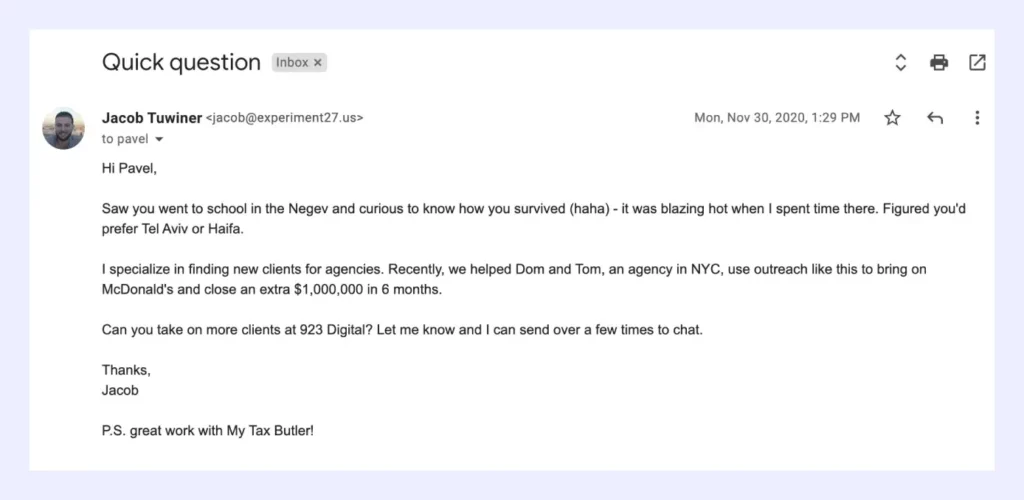
Source: Jacob Tuwiner
If you're still confused, you can start with a compliment or a relevant reference to boost your prospect's ego. After all, some flattery never hurts. You can:
- Congratulate them on their recent achievements
- Compliment their latest blog post
- Ask for advice
Here are some examples you can use:
- I came across your recent article on [topic] and completely agree with your opinion. It's refreshing to connect with someone who shares a similar perspective.
- Your tweets about [industry challenge] caught my attention. It's evident you're dedicated to addressing this issue, and I'd love to hear your thoughts on potential solutions.
- Your recent achievement in [project] is truly impressive. It's always inspiring to connect with dedicated individuals who are actively shaping the [industry].
- Your unique perspective on [relevant topic] shines through in your LinkedIn posts. I believe your insights could contribute to an interesting conversation.
- Congratulations on your recent promotion at [company]! It's truly inspiring, and I'd love to connect to hear more about your new role and vision.
3. State the Purpose of Your Email
You now have your prospect's attention and curiosity. Don't leave them hanging. Let them know why you're reaching out.
Do you want to schedule a sales call? Tell them how your product can solve their pain points and be as relevant as possible. Remember to inform, not push. This makes them feel you're genuinely interested in them and are not another random sales professional blasting the same message to hundreds of contacts on a list. Plus, it tells them what to do next.
Remember, the purpose of your email must align with the prospect's interests and pain points. Stating it clearly will set the tone for the rest of your email and guide the prospect toward understanding why your offer is relevant to them.
For example,
- I'm reaching out to see if you're open to checking out some new opportunities to [achieve a specific goal].
- I noticed you have a remote team. We've helped [Company 1] and [Company 2] manage their remote teams efficiently with [your solution]. I can help you achieve [specific goals], too.
4. Emphasize Shared Connections or Interests
Highlighting common ground between you and the email recipient can serve as an excellent icebreaker. This can be as simple as:
- Mentioning a mutual connection
- Highlighting a shared interest
- Referencing an event you both attended
Why is this important? Because when sending an introductory sales email, more often than not, you're reaching out to prospects who have no idea you exist. Highlighting shared connections establishes familiarity, making your email feel less like a cold pitch and more like a genuine conversation.
But what if you can't find common ground? You can still build a connection by talking about something relevant to them. A little detective work through their social media handles can help you identify their areas of interest.
You can bring up subjects like hobbies they've expressed interest in or their recent industry insights. After all, building a connection is all about showing genuine interest and engaging on topics that resonate with them.
Here are some examples:
- I noticed from your LinkedIn profile that you strongly advocate for sustainable technologies. Your commitment to driving positive change aligns perfectly with our innovative solution designed to reduce environmental impact.
- [Mutual connection] mentioned you two recently collaborated on a project. It's always inspiring to hear about successful collaborations, and I thought it would be great to connect and explore how our expertise in [relevant area] could complement your team's efforts.
5. Deliver Value in Your Message
It's simple psychology. When you offer something valuable to a person, they feel obliged to return the favor. We're not talking about writing a lengthy monologue explaining the value your product brings to the table. We're talking about making your email message more valuable. You can do this by:
- Recommending a relevant blog
- Attaching a free e-book
- Suggesting a tool, etc.
The idea is to enrich your email with valuable nuggets that resonate with them. It shows you're genuinely interested in their growth and not just pushing for a sale.
You can say something like: "I was genuinely impressed by your insights on [relevant topic]. Your expertise truly shines through. As someone who's passionate about [shared interest], I thought you might find this blog/e-book/tool quite valuable."
6. Include a Clear Call-To-Action (CTA)
A clear and compelling CTA is like a road map. It guides your prospect on what you'd like them to do next.
- Do you want additional information?
- Do you want them to schedule a meeting?
- Do you want them to visit your website?
A well-crafted cold email call-to-action simplifies their decision-making process and encourages them to take action. Make sure you position it strategically within your email. As a thumb rule, place your CTA near the end of your email after you've made your case.
Plus, stick to only one CTA per email. Focus on the most important action you want them to take.
Finally, use soft CTAs. They gently invite the recipient to engage at their own pace and are ideal when you're reaching out to them for the first time. Soft CTAs help you initiate a conversation and build relationships without pressurizing the prospect. For example:
- What are your thoughts on [topic]?
- Are you interested to explore [solution]?
- If you're curious to explore further, check out this link.
- Take a sneak peek into [solution] and let me know your thoughts.
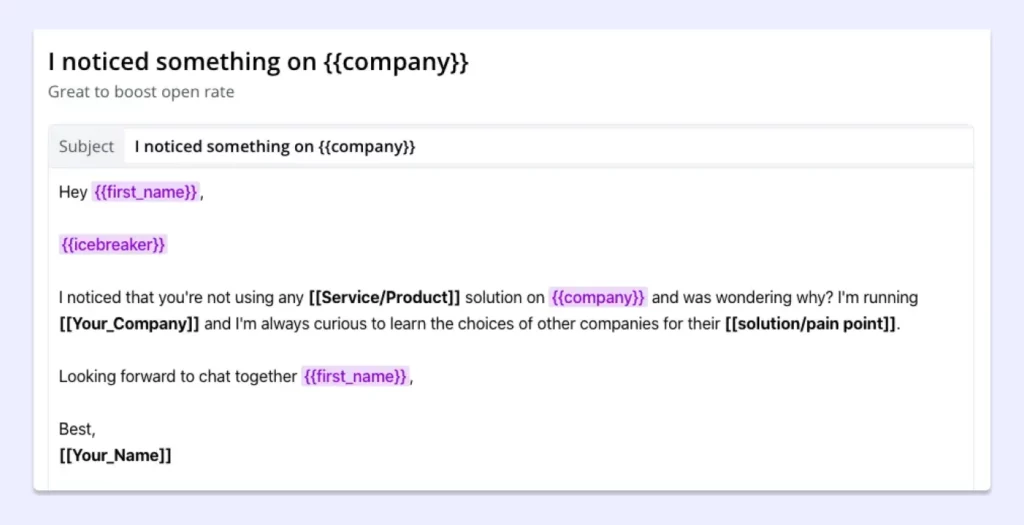
Source: Breakcold
7. Have a Professional Email Signature
If your sales introduction email was a well-prepared gourmet dish, the email signature would be the final garnish. It completes your message, elevating your email from ordinary to remarkable.
Why does it matter? Because it helps the prospect learn more about you. A professional cold email signature helps establish your credibility, nudging the prospect to take action.
Here are some elements that your sales introduction email must include:
- Your full name
- Your job title and the company you represent
- Your contact info, like phone number and business email address
- A link to your LinkedIn profile
- A link to your calendar
- Your company's logo
- Legal disclaimer (if needed)
Here's an example:
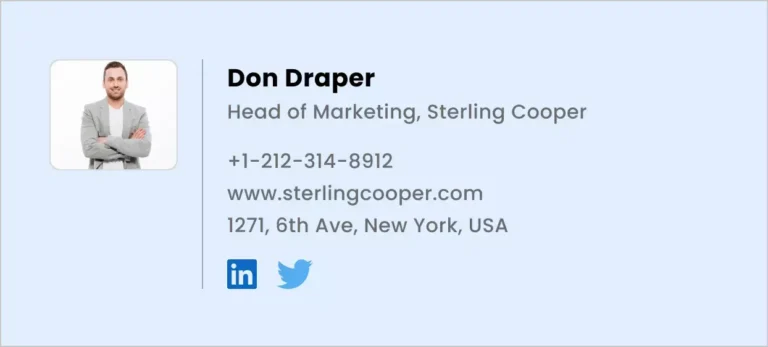
5 Sales Introduction Email Templates That Get Replies
Ready to take your sales introduction emails to the next level? We've got you covered with five awesome sales email templates that are guaranteed to grab attention and elicit responses.
1. Sales Introduction Email to Prospects via Cold Email
When reaching out to prospects via cold email, your goal is to pique their interest and leave a lasting first impression. Cold emails are unsolicited messages sent to individuals who may not be familiar with your brand. Therefore, the key is to craft a compelling introduction email that captures their attention, addresses their pain points, and encourages them to take action.
Here's a sales email template you can use:
Subject line: Elevate your [specific function] ROI with [your solution]
Hi [recipient's name],
I saw your recent LinkedIn posts on [topic] and was genuinely impressed by your expertise in [their field].
I'm reaching out to see if you'd be interested in exploring new opportunities to [achieve goal].
I work with [your company, followed by a brief description of what it does]. We've helped leading brands like [Company 1] and [Company 2] achieve [similar results].
Would you be interested to learn how we can help you [achieve goal]?
Looking forward to hearing from you.
Best,
[Your name]2. Adding Humor to Your Introduction Email
Who says your introductory sales emails have to be dull and boring? Using a dash of humor is an excellent way to break the ice and make a more human connection. It adds a touch of personality, helping you stand out amidst a sea of generic messages. Plus, it can leave a lasting impression, increasing your chances of getting a response.
Let's look at an introduction sales email template:
Subject line: Revealing cat-approved solutions for [pain point]
Hi [recipient's name],
Do you know what a cat's favorite dessert is?
Before we unravel that mystery, I want to say a quick hello. I'm [your name] from [your company], and I don't intend to bombard you with silly cat jokes.
I wanted to reach out to understand how you're tackling [common pain point]. [Solution] can help you round up those challenges and drive higher ROI.
If you're interested to learn more, I can schedule a quick call for next week.
Let me know what you think.
Oh, and the cat's favorite dessert? It's mice cream!
Have an awesome day.
[Your name]3. Introductory Email for Someone Whom You Met in Person
When reaching out to someone you've met in person, you don't need to go all formal and reintroduce yourself. Just shoot them an email that reminds them of your previous email and smoothly transitions into discussing how you can help. Plus, since you’re already familiar with the prospect, you can also use a hard CTA.
Here's a sales introduction email example:
Subject line: [Recipient's name], nice meeting you at [event]
Hi [recipient's name],
It was great meeting you at [event] yesterday. Your insights on [topic] were quite refreshing.
I understand you're focusing on achieving [specific goal]. At [your company], we've helped leading brands like [Company 1] and [Company 2] achieve [similar goals].
If you're interested in exploring this further, we can catch up over a virtual coffee. Does Tuesday, 2 p.m. work?
Looking forward to hearing from you.
Best,
[Your name]4. Sales Introduction Email by Leveraging Mutual Connections
Mentioning a mutual connection is like a golden ticket to catching your prospect's attention. It creates an immediate sense of familiarity and trust. Plus, it's way more effective than sending random cold emails to strangers.
But make sure you include the acquaintance's name right in the subject line to instantly grab their attention. Let's look at a template.
Subject line: Do you know [mutual contact's name]?
Hi [recipient's name],
[Mutual connection] suggested I reach out to you.
I'm [your name] from [company name]. We [briefly describe what your company does].
I understand you're trying to [solve specific pain point].
We've recently helped [Company 1] and [Company 2] achieve [similar goals].
If you're interested in exploring this further, you can schedule a meeting on my calendar here.
Looking forward to your response.
Have a great day.
[Your name]5. Trigger-Based Introductory Email
A trigger-based sales introductory email is like sending a perfectly timed digital handshake. It is prompted by a specific event or action taken by the prospect. This could be anything from downloading a resource from your website to attending a webinar you hosted. These emails have better chances of engagement and conversion as they are relevant to the prospect and guide them further down the sales funnel.
Here's a template you can use:
Subject line: [Recipient's name], your [downloaded resource] is here!
Hi [Recipient's name],
Congratulations—you've officially become a [your company] insider by grabbing our [downloaded resource]!
Here's your copy.
But why stop at a simple download when you can enjoy an even richer experience?
I'd love to chat with you about how [your solution] can complement the insights you've gained from [downloaded resource].
Let me know if you're interested.
Best,
[Your name]Elevate Your Email Game With an Unforgettable Sales Introduction
All you need to master the art of sales introduction emails are clever words and the right email strategy. From witty subject lines to personalized openings, these sales email templates will help captivate your prospect's attention, ignite curiosity, and build meaningful connections.
But here's the burning question: How do you personalize your sales introduction emails at scale? That's precisely where a cold email software like Klenty steps in.
Klenty comes with advanced email personalization features like liquid templates to change the content of your emails based on when the prospect receives and opens the email. Plus, it allows you to assemble email sequences automatically, ensuring your outreach maintains the essential human touch, no matter the scale.
Curious to know more about how Klenty will help you write effective sales introduction emails that get replies? Book a demo now!
Resources You’ll Love:
FAQs
1. How Do You Write an Introduction Email for Sales?
Here's how:
- Start with a catchy subject line.
- Introduce yourself and your company briefly.
- Mention a mutual connection or shared interest.
- Highlight the value you bring and how it addresses their needs.
- Include a clear CTA.
- End with a professional email signature.
